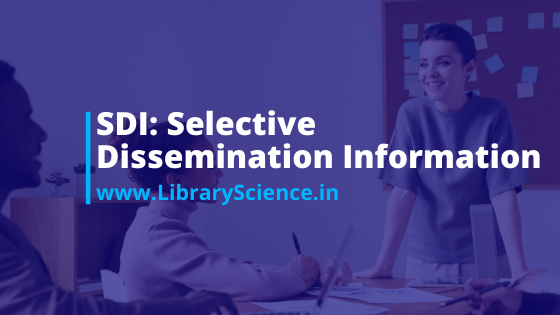SDI (Selective Dissemination Information) | Element & Steps of SDI
Luhn defined SDI (Selective Dissemination Information) as SDI is a machine-assisted service provided by any organization that receives and delivers the latest information where it is needed.
All types of
topical awareness services are operated manually. After the advent of the
computer in 1950 AD, efforts were made for its application to library and
information works. Hans Peter Luhn proposed a computer usage method for topical
awareness service in 1961, he named the method of automated topical awareness
service, selected information broadcasting or SDI.
The set of
each piece of information is selected for transmission to the user related to
the computer. Hence this service is called Selected Information Broadcasting.
Selective
Dissemination Information (SDI) Service is aimed at an individual or a small
group, yet attempts are made to make SDI broadcasts as needed by an individual
or a small group.
Thus, the user gets only the information he wants or selects. In this way, the user gets
only such information. Which is useful for him.
 |
| SDI - Selective Dissemination Information |
Element of SDI (Selective Dissemination Information)
SDI system can have the following components or elements
1. A
Document Database - This is a file containing the description of the document
and the words representing the subject matter. Since SDI is a computer-based
service, the database of the document is readable on a computer. The database
in SDI is for timely literature.
2. Set of
user-profiles - This is a file that describes the subject of the user's
interest. The user file is also a computer-readable file. Creating user
profiles is an important task. User-friendly words are taken from the same
vocabulary list used to index the contents of the document data.
3. Matching
Profiles - This involves the computer mixing the documentation with the user
details. This is actually done by the program working inside the computer.
4. User
Interface - Interface is a common limitation that allows for useful
communication. The interface is the main function in the SDI (Selective
Dissemination Information) service.
Steps of Selective Dissemination Information
There are
four stages of SDI which are as follows:
(1)
Selection -
In the selection side of SDI, the computer program within the database matches the keywords of the new document according to the subject of interest of the user.
In the selection side, documents are selected to broadcast only those documents that satisfy the user profile (search expression) given the user's interest.
(2)
Notification - After selection, the selected material has to be notified for
broadcast. Normally, notifications are in the form of abstract or abstract
reference lists as the SDI service is for new notifications.
Therefore,
it is important that adequate information is given about the documentation in
this service.
Emphasis is placed on the authoritative description of all
documents included in the SDI service. Selected documents are notified with
computer program documentation matching.
(3) Feed
Back: - The notification has two parts-
- User parts
- Reinvestment portion
Some
questions in the reinvestment section are about the usefulness of documents.
The user is asked to reply to the notification, that is, the user receives the
information related to the document related to his interest, in view of their
usefulness and need for themselves, and reacts to that document. Many times,
the user's subject interest also changes
In this way,
sends its response to the library and information specialist. The expert
analyzes these reinvestments. And improves user profiles on the same basis.
(4)
Modification - After receiving notification there is a meaningful interaction
between the "SDI system and usage".
When the user of his reinvestment
reveals that his requirements have not been met, then the information expert
will modify the user profile.
Sometimes. Starting with new projects also
changes the user's interests. The changing interests are adjusted in his / her
profile. Thus the user profile is modified regularly.
(5)
Resolution of the will of the readers - If a particular reader demands an
original copy of a document, it is provided to him.
To Know More About Library Science Click on the Link Given Below
| ||
1. Library and Society
| ||
2. Library Management
| ||
3. Library Cataloging
| ||
4. Library Classification
| ||
5. Information Source
| ||
6. MCQs on Library Science
| ||
8. Jobs in Library Science
| ||
Join Library Science Group for Latest Updates
| ||

Post a Comment